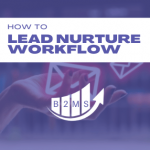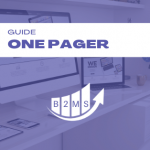How to Create & Measure Revenue-Driven Lead Nurturing Email Sequences
As a marketer, it’s crucial to have a successful lead nurturing strategy in mind. Lead nurturing emails are one of the most effective ways to convert captured leads into customers.
In fact, let’s look at three lead nurturing statistics that will convince you to start to nurture your leads:
- Regarding Gleanster Research, 50% of leads are qualified but not ready to make a purchase yet.
- Companies that nurture their qualified leads generate 50% more sales qualified leads (Source: Forrester Research)
- In addition, Forrester Research states, effective lead nurturing emails reduce the cost per lead by one-third.
Let’s put this in our own words, half of the generated leads are good leads but need to be nurtured. When implementing lead nurturing emails correctly, you can double your sales leads and reduce your cost per lead by 33%. Sold on the concept? Good, let’s explore what and how to do it effectively!

Definition of Lead Nurturing Emails
Lead nurturing emails are a series of emails that your business’ marketing or sales team sends to your leads to keep them engaged with any product or service you offer.
Each email is designed to nurture your leads by providing valuable content. This content can be updates concerning your services/products, industry news, or helpful tips.
In other words, it’s about providing your leads with overall value, making them deem your business knowledgeable and distinctive.
What Are the Different Use Cases for Nurture Emails?
Email marketing requires serious work involving customer segmentation, understanding pain points, and devising the perfect subject line.
So, why would you work so hard for a lead nurture email campaign? Here are the most important reasons.
Establishing Salience
Salience, or prominence, in marketing means that your brand comes first to the consumer’s mind when they think about a specific product or service.
You can achieve solid salience with email-based marketing campaigns, as you ensure you’re staying in touch with your leads and prospects.
This part is especially true if you’re selling a high-value product or service that needs long sale cycles.
Build Trust and Relationships with an Email Nurture Stream
Once you establish an email list and verify who your leads are, you can start building trust and relationships with them.
When you show them how knowledgeable, innovative, or trustworthy you are, you’ll make sure they pick you whenever they want to buy or subscribe.
Educating and Nurturing Leads
When you send an email within a lead nurturing process, you want to educate your leads. This makes them see your business as a high-value brand.
Education possibilities are broad. You can educate them on your product or service, updates within a specific industry, as well as the best tips and tricks to succeed within their business scope.
Cost-efficiency of Email Nurture Cadence
Lead nurturing emails are one of the most cost-efficient ways to expand your business. All you need is to get an email address.
Then, you can build an email list that you can use to reach numerous people that are interested in whatever your business has to offer.
Improving Conversion Rates with Lead Nurturing Campaigns
Lead nurturing campaigns help you stay in touch and provide valuable information to your leads.
When you do that well and combine it with establishing trust, your conversion rates will skyrocket. After all, people always choose the brands that are easily available to them.
What Are the Different Content Types for Different Lead Stages?
To devise the ideal content strategy, you have to understand where your leads are in the customer journey or sales funnel.

Top of the Funnel: Problem unaware, problem aware but solution unaware
During this stage, you want to grab your prospects’ attention. It’s the education phase. Most people don’t know that they have a problem, or don’t know that a solution to their problem exists. If you capture a lead at this stage, you need to establish trust and present yourself as a thought leader and expert.
It’s too early for a trial or product comparison. For example, this blog post sits in this stage. You are aware of lead nurturing, but don’t compare products yet.
This stage is great to capture leads with gated content, like an informational lead magnet. This can be an ebook, webinar or an event.
Middle of the Funnel: Solution aware
This phase is also often referred to as the consideration stage in the sales funnel. Now it’s about showcasing your product/solution.
Good email content could be case studies, comparison, testimonials, or how certain features specifically help with the pain points.
It’s important to gauge engagement to not burn any bridges. If a lead is not engaging with this type of content, don’t force this type of content on a potential buyer and continue with informational content.
Bottom of the Funnel: Product aware – purchase & post purchase
The last stage of the funnel is the conversion stage, where your product aware leads become customers. Additionally, it’s also the stage where you increase the customer lifetime value (CLTV).
Your email list is now in the stage to evaluate which option is best for them, free trials, discounts, special onboarding are all incentives to get someone over the hurdle. It does not have to be a special offer, sometimes just offering a conversation or including the call to action to get started is enough.
It’s also a great time to launch an onboarding sequence and how-to tips in the form of videos, webinars, or a knowledge base.
If you can tie platform engagement to the nurture emails, that is most helpful for your marketing, as well as the customer. For example, if someone hasn’t tried a specific feature yet, you can educate someone on the benefits and also how-to use it. If someone spends a lot of time with one task that can be optimized, help her with useful hacks.
You can send these emails after a customer has had a positive experience with your product or service.
Finally, you can send emails at set intervals. For example, an email that goes out every six months to a customer who’s used your product or service once before.
Generally speaking, there are plenty of ways to help you optimize your lead nurturing workflow, and we’ll talk about them extensively in the next two sections.
What Are the Important KPIs? What to Focus on?
You should keep track of your lead nurturing emails. This helps you determine which emails are most effective and which need more work.
Tracking your emails’ performance makes you understand what content resonates best with your leads. In turn, it helps you provide them with the information that’s most relevant and valuable to them.
So, how can you do so? Let’s look at some metrics that can help you determine how well your lead capture campaigns are effective.
Deliverability Rate
It all begins with deliverability, which is the success rate of your emails being delivered to the correct email address.
Deliverability rate = Number of successful delivered emails / number of emails sent * 100
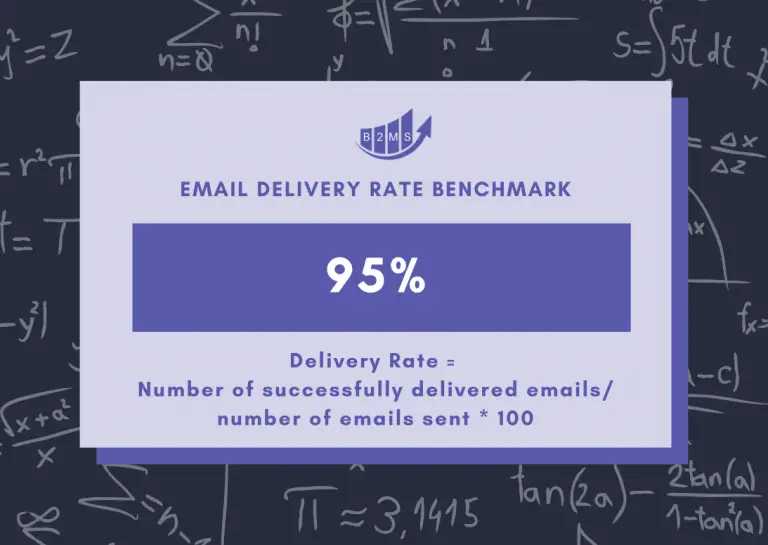
The best way to enhance deliverability rates is by making sure that your marketing team regularly checks the validity of your email list and how customers are engaging with the emails. Marketers can use validation services or use double-opt ins to ensure a correct email address.
Another best practice is to warm the sender’s email address by segmenting the list and start with verified emails – ideally to those leads that are likely to engage.
Lastly, deliverability can also depend on your email marketing software or email provider.
A good deliverability rate is 95%, but realistically, you will find for blast emails rates around 80 – 85%.
Hard and Soft Bounce Rates
Bounce rates are divided into hard and soft bounce. Soft bounce means that the recipient is “temporarily unavailable”. This can be because the mailbox is full or receives too many emails at the same time. Resending is possible and can sometimes mean successful delivery.
Hard bounce emails, on the other hand, means that the email address is invalid, and the email cannot be delivered. You should definitely remove all hard bounce emails.
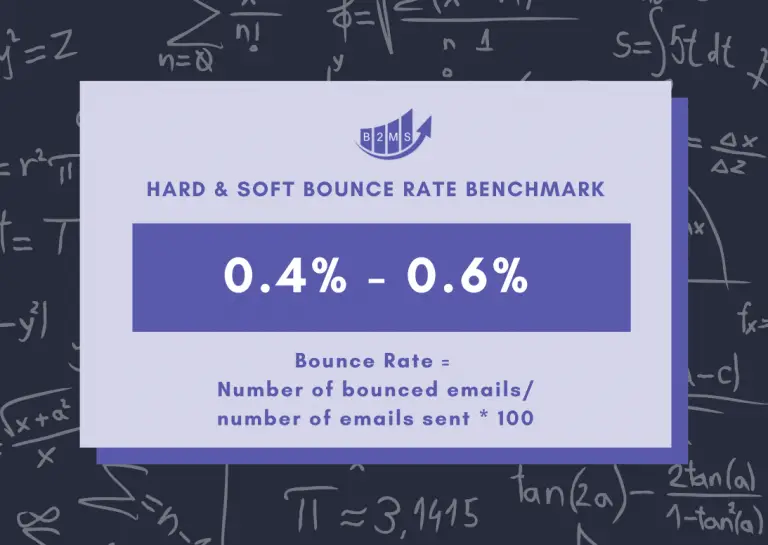
Benchmarks for soft bounce are 0.6% and hard bounce 0.4%. Again, a double opt-in and email verification is enormously helpful. In addition, you should regularly remove repeating non-delivered soft bounce addresses.
Open Rate
Open rate refers to how many people open your email and check out its contents.
Open rate = number of emails opened / number of emails delivered * 100
You can increase the open rate by devising appealing subject lines and making the first few lines of email count.
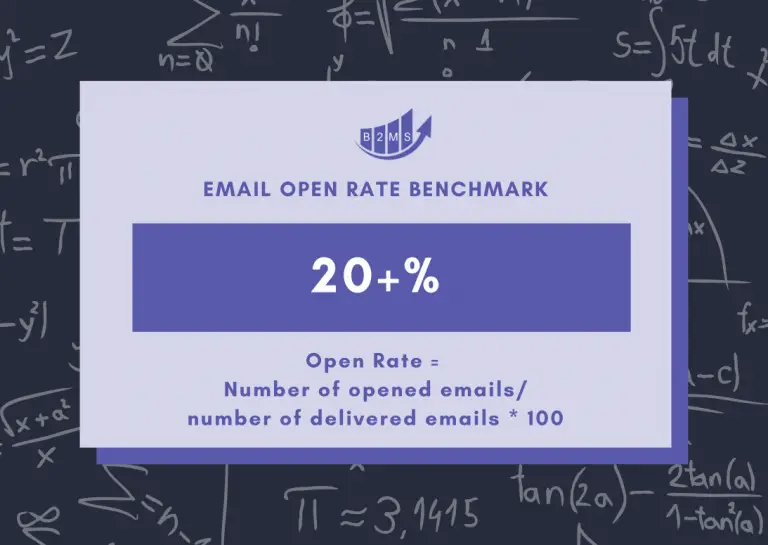
The benchmark for open rates varies by the industry you are in, but the global average lies around 20+ %.
Click-Through Rate (CTR)
The click-through rate measures how many people clicked on the prompt in your email.
Click-through rate = Number of clicks / number of emails delivered * 100

You can increase this rate by providing valuable reasons for your customer to click. For example, giving them a free brochure, ebook, or software trial.
Regarding Mailchimp, the CTR benchmark for marketing emails is 2.6%.
Unsubscribe Rate
While it’s not necessarily bad to remove unengaged people who don’t want to hear from your email nurture streams, unsubscribe rates shouldn’t be too high.
First, you need to include an unsubscribe link to every marketing email to comply with data and can’t SPAM regulations.

A healthy unsubscribe rate does not exceed an average of 0.26%.
In the risk of sounding like a broken record, only emailing people that really want to hear from you is the best advice. A double-opt in is beneficial. Furthermore, remove unengaged people from your nurture email sequences proactively – at least reduce the cadence.
The Move of the Lead Stage or Conversion Rate
Moving through lead stages is a sign that your campaigns are doing well. The conversion rate can be calculated by dividing the number of conversions by the number of total visitors.
Conversion rate = Numbers of conversions / total audience * 100
To increase this rate, you’ll have to make sure that your content has what the customers are looking for.
Tools to Help You Build Lead-Nurturing Emails
When it comes to lead-nurturing emails, you’ll want to ensure a couple of factors for your campaign to work. Let’s delve into them.
Proper Customer Segmentation
One of the best ways to deploy lead nurture software is to use it for customer segmentation. This is the first step towards sending the right emails to the right email list.
Once you do that, you can personalize what everyone receives depending on the buying cycle they’re in.
Moreover, you can move on to more complex stages once you get that part covered. Websites like Clickfunnels and Hubspot can help you with that through CRM.
Sending the Right Content to the Right Customers
You must send leads emails depending on where they are in the marketing funnel. For the ones at the top of the funnel, you can focus on informational content. The further someone is along the buyer journey, the more data enrichment needs to take place. You can collect further lead information by download or registration forms.
Tools like Builderall can help you with that—especially across various channels like emails, Whatsapp, SMS, and Telegram.
Tracking Email Campaign Metrics
The last part is to track your metrics and make sure everything’s up to speed. If not, you’ll have to implement some changes to your strategy.
An excellent tool to do so is Pipedrive.
Pipedrive allows you to set up pipeline stages, focus on sales, track progress, and optimize your sales process through analytics.
Final Thoughts
Lead nurturing emails are an essential part of any successful lead generation and conversion strategy.
By creating a series of emails that are tailored to your leads’ interests and needs, you can build trust and nurture your lead.
Consequently, you’ll be expanding your customer base and growing your business.
Now it’s time to find the right software for your lead nurturing campaigns.

Sascha is a Lifecycle Marketing Consultant with over 8 years of digital marketing experiences in Silicon Valley, the UK, and Germany.
After leading the demand generation for a 100+ million company, he decided to venture out on himself. He’s now helping clients to attract and convert more leads and customers.
His main focus are SEO, paid media & marketing automation – all with the focus to tie marketing campaigns to revenue.
Sascha has been featured in industry publications.

